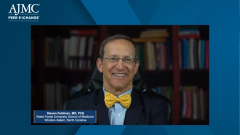
Mechanism of Action: Treating patients with Mild to Moderate and Moderate to Severe Acne
A look at the most common medications used in patients with acne.
Episodes in this series

Casey Butrus, PharmD: Hilary, we have many different treatment options for acne, different mechanisms of action that have been around for decades. Can you give us a quick overview of how you approach patients, those with mild to moderate acne vs the more moderate to severe population?
Hilary Baldwin, MD: You started by talking about how old our acne medications are and, indeed, we have an aging population of medications. [Doxycycline] and benzoyl peroxide are 60 [years old], minocycline and tretinoin are 50 [years old], and isotretinoin is 40 [years old]. But it’s not because we don’t have newer, better drugs. Those are oldies but real goodies. And for most of my patients, I think most of us who spend our time in the trenches with acne primarily believe wholeheartedly in retinoids…in every kind of acne, mild, moderate, all the way up until the patient is midway through a course of isotretinoin and I’m still using a topical retinoid, and I’m adding to it benzoyl peroxide. I rarely use a topical antibiotic for that purpose without [having] benzoyl peroxide involved. Then as the [patient’s acne] gets a little bit more severe, oral antibiotics, hormonal therapy in women, and as [it gets] even more severe, isotretinoin. And then, of course, there are many other medications that we might use, but that’s an overview of the most commonly used medications that we have.
Casey Butrus, PharmD: I know you mentioned using hormonal therapy in women. Do you treat men and women differently…?
Hilary Baldwin, MD: [Sex] does play a role because we have all those psychological issues that we just talked about. Additionally, some of our adult female patients will have acne down in the U zone, which is frequently harder to treat. Also, it’s extending onto the neck where you can’t really use most of your topical acne medications because they’re simply too drying. So we have those considerations often. For example, in the adult female with neck involvement, we have to go to some of our newer topical agents with wonderful vehicles that make them more tolerable for use…. It is said and has been demonstrated in lots of the post hoc analysis of phase 3 data that most of our topical medications are more effective in adult women than they are in the younger population, and certainly compared with a teenage boy, for example. And it’s been said that that’s because adult women are more adherent to their therapy. Do you agree with that statement, Steve?
Steven Feldman, MD, PhD: Generally speaking, I would say so. I used to think that women were inherently more adherent than men because I do believe they’re more responsible. But coming with that responsibility, I think there’s a tendency for women to look at package inserts more carefully than guys.
Hilary Baldwin, MD: That’s true.
Steven Feldman, MD, PhD: So there’s a bit of a yin-yang going on. I’m more responsible, I’ll use it. I’m looking at the adverse effects, I’m not going to put this on. I think it’s less of a problem with our acne treatments than with, say, topical steroids where they’re looking at the adverse effects. I suspect overall that with respect to acne, I know this is going to sound crazy, but I think the teenage boys aren’t fully adherent to the treatment.
Hilary Baldwin, MD: Never heard that before. Never experienced it.
Arash Mostaghimi, MD, MPH: Breaking news here…
Hilary Baldwin, MD: The only other thing I can think of is that until recently we didn’t have a good way to suppress sebum production in men because the medications we had at our disposal were either inappropriate, birth control pills, spironolactone, or isotretinoin, which, of course, not every male patient is appropriate for. So we didn’t have a way to hit that fourth pillar that Steve was talking about before of sebum production, which is foundational in acne because, as he mentioned, no sebum, no acne. But now of course we have a topical sebum inhibitor, which is safe in men. And that’s a new concept that occurred since the last guidelines over the past couple of years.
Transcript edited for clarity.
Newsletter
Stay ahead of policy, cost, and value—subscribe to AJMC for expert insights at the intersection of clinical care and health economics.









































